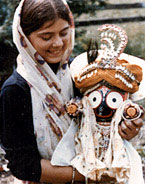Vaisnavi Sanga is a place where the vaisnavis can exchange knowledge, talents, experiences, information and inspiring each other! By clicking on the flags above you can access the blog content in English or Portuguese, as you prefer. You can also share your realizations with us and get it published here by sending an e-mail to vaisnavi-sanga@hotmail.com. Welcome!
Your servant
Vaisnava Krpa devi dasi
Vaisnavi Sanga é um lugar onde as vaisnavis podem trocar conhecimento, talentos, experiências, informações e inspirarem-se umas as outras. Clicando nas bandeiras acima você pode acessar o conteúdo do blog em inglês ou português, como preferir. Você também pode compartilhar suas realizações conosco e tê-los publicadas aqui enviando um e-mail para vaisnavi-sanga@hotmail.com. Seja bem-vindo(a)!
Sua serva












